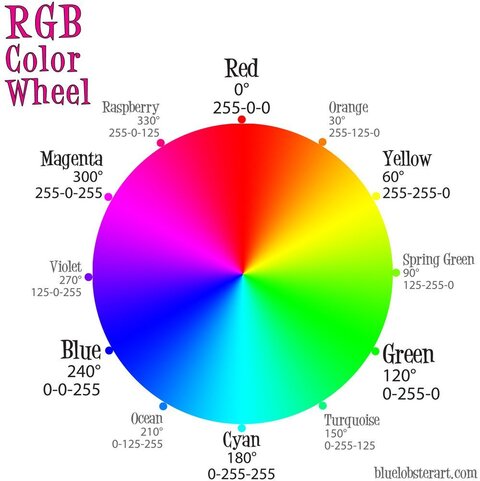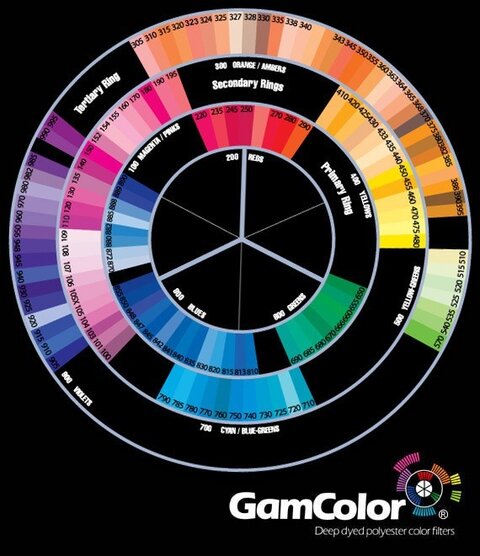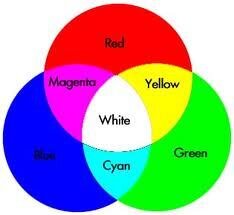Okay, so here's a question. I have a theatre student who is staging a production in which she wants to use seven colors in seven smart lights which would eventually merge center stage to make white--without changing the smart light. Her production concept is amazing; however, not certain if her lighting idea will work. Is this possible? What colors could be used--and at what intensity--to create this effect. Can anyone help a non-lighting savvy teacher help her student? Imagine a circular stage with seven different colored lights following seven actors to the center of the stage. When the seven characters meet in the center the light actually merges to form white. She is attempting to use color mixing theory to support her idea.
You are using an out of date browser. It may not display this or other websites correctly.
You should upgrade or use an alternative browser.
You should upgrade or use an alternative browser.
Color Mixing with Seven Colors to Make White
- Thread starterMrsZ
- Start date
Well MrsZ, today is your lucky day! Here in the USA (and world-wide), we have a company called ETC-Selador. They make a variety of LED fixtures, almost all of which use seven colors of LED. Different models use slightly different colors, or differing quantities of each color, however. Each intended for a specific purpose.
The seven colors are (for the Vivid-R, each model varies slightly: Red, Red Orange, Amber, Green, Cyan, Blue, Indigo. (Font colors VERY approximate!)
According to the SeladorToolkit iPhone app (Do you have iPhone/iPod/iPads in South Korea? I'm sure you do. It's a free app, and fun to play with.)
(for the Vivid-R), to make "WHITE" the percentages are:
Red-83%, Red Orange-100%, Amber-100%, Green-100%, Cyan-80%, Blue-61%, Indigo-0%. (For your application, you'll have to cheat a little on the Indigo and use it above 0%, your result will skew toward Blue, but you can't add more Red or Green, they're already at 100%.)
The percentages and colors will vary muchly depending on your fixtures' light source (incandescent, gaseous discharge, arc, etc.), and their color mixing system (RGB, CMY, etc.) You could probably accomplish something close with gels in conventional (non-"smart") lights. If you tell use what brand (Lee Filters, RoscoLux, E-Colour, etc.) of colour media you use or have access to, and what your lamps are, we can help with specific color filter numbers.
The circular stage will be a problem if you have each light 1/7th of the way around the circle. All seven may mix to WHITE on the floor at center, but won't mix in the air until they hit something. So it will look different to every audience member if they're sitting all the way around the stage.
This is all theory--I've only mixed colors with three lights using Red, Green, and Blue colors, see RGB Color Mixing. If you try it and have satisfactory results, please post back here with what you did, how it worked, and if possible, pictures. We love pictures.
The seven colors are (for the Vivid-R, each model varies slightly: Red, Red Orange, Amber, Green, Cyan, Blue, Indigo. (Font colors VERY approximate!)
According to the SeladorToolkit iPhone app (Do you have iPhone/iPod/iPads in South Korea? I'm sure you do. It's a free app, and fun to play with.)
(for the Vivid-R), to make "WHITE" the percentages are:
Red-83%, Red Orange-100%, Amber-100%, Green-100%, Cyan-80%, Blue-61%, Indigo-0%. (For your application, you'll have to cheat a little on the Indigo and use it above 0%, your result will skew toward Blue, but you can't add more Red or Green, they're already at 100%.)
The percentages and colors will vary muchly depending on your fixtures' light source (incandescent, gaseous discharge, arc, etc.), and their color mixing system (RGB, CMY, etc.) You could probably accomplish something close with gels in conventional (non-"smart") lights. If you tell use what brand (Lee Filters, RoscoLux, E-Colour, etc.) of colour media you use or have access to, and what your lamps are, we can help with specific color filter numbers.
The circular stage will be a problem if you have each light 1/7th of the way around the circle. All seven may mix to WHITE on the floor at center, but won't mix in the air until they hit something. So it will look different to every audience member if they're sitting all the way around the stage.
This is all theory--I've only mixed colors with three lights using Red, Green, and Blue colors, see RGB Color Mixing. If you try it and have satisfactory results, please post back here with what you did, how it worked, and if possible, pictures. We love pictures.
Last edited:
kicknargel
Well-Known Member
I would think that if you look at a color wheel (like this:
 ) you could pick any 7 colors that are equadistant around the wheel and they would mix to white. As mentioned, only in a perfect world. The specific qualities of your sources and color media will cause variance--for example with incandesent sources warm color transmit much better than cool ones. Also as mentioned, if the colors are coming from different angles, they won't really mix on a 3D object (person) but create a rainbow effect.
) you could pick any 7 colors that are equadistant around the wheel and they would mix to white. As mentioned, only in a perfect world. The specific qualities of your sources and color media will cause variance--for example with incandesent sources warm color transmit much better than cool ones. Also as mentioned, if the colors are coming from different angles, they won't really mix on a 3D object (person) but create a rainbow effect.
Ooh, even easier, GAM publishes a color wheel, with gel numbers right on it.
 ) you could pick any 7 colors that are equadistant around the wheel and they would mix to white. As mentioned, only in a perfect world. The specific qualities of your sources and color media will cause variance--for example with incandesent sources warm color transmit much better than cool ones. Also as mentioned, if the colors are coming from different angles, they won't really mix on a 3D object (person) but create a rainbow effect.
) you could pick any 7 colors that are equadistant around the wheel and they would mix to white. As mentioned, only in a perfect world. The specific qualities of your sources and color media will cause variance--for example with incandesent sources warm color transmit much better than cool ones. Also as mentioned, if the colors are coming from different angles, they won't really mix on a 3D object (person) but create a rainbow effect. Ooh, even easier, GAM publishes a color wheel, with gel numbers right on it.

lwinters630
Well-Known Member
MrsZ,
Color mixing theory actually begins with white and is then broken out into the spectrum, like the rainbow. So theoretically 7 colors can be put back together to get white. Lets add the realities of mixing on stage. As mentioned earlier, Light is a reflected value and is only seen when it strikes an object, like a piece of paper laying flat on the center of the floor, haze in the air or large box on the stage. If the paper is white, than as each color lands on it, it will reflect back to your eye. As red strikes the white paper it will reflect all the red. add a blue light and it will reflect both as purple light. As green light strikes the white paper along with the red and blue, then it will reflect all of the light and appear white. That is because white is made up of all colors therefore will reflect all colors.

 This is called the additive quality (adding colors).
This is called the additive quality (adding colors). subtraction hapens if the paper started out as blue then it will absorb all colors except the blue, allowing it to be reflected back to our eyes. Shining red light on the blue paper will make it appear black because it is absorbing all the red and nothing is reflected. If you shine purple (secondary color made of red and blue) then the paper will absorb the red and reflect the blue. In other words you can not make a "painted" blue object white. If the paper is black, in theory, it will absorb all colors of light and reflect nothing.
What if there is a haze in the air, then mixing color in the air (air graphics), should in theory, as the 7 different colors sweep through the air to the middle of the round stage and collide at 5 feet off the floor, it should be white (not tested)
A seven sided box placed on the stage and each of the lights, lite one side of the box, they would not mix fully.
All that to say she may have better results putting all the lights over the center of the stage, pointing out at the seven people as they walk towards the center of the stage. when all of them reach the center, the light beams mix over the center and appear white. shadows and other areas will not be fully mixed due to beams of light being blocked.
Quite a great project to pick and do.
This is just a quick thought but you might be able to achieve this effect without actually trying to accurately mix any light. If when all of the light merge in the center you add white light from another source and bring the intensities of the colors down a bit you might be able to wash out the colors fairly well and achieve an effect that seems as if the lights are mixing. I have no evidence to back up what I am saying so at this point it is just an idea.
Les
Well-Known Member
This is just a quick thought but you might be able to achieve this effect without actually trying to accurately mix any light. If when all of the light merge in the center you add white light from another source and bring the intensities of the colors down a bit you might be able to wash out the colors fairly well and achieve an effect that seems as if the lights are mixing. I have no evidence to back up what I am saying so at this point it is just an idea.
It would work, but since this is a project to support color theory, I think they call that cheating.
Wow. This sounds like a really cool project. I think your biggest issue is while the stage and dust/haze in the air will probably mix just fine, the people will not. What fixtures are you using. Knowing that would change what values would be most useful.
I have seen something similar to this done before. We used a number of S4s from the catwalk to create a large semi-circle of different colors large enough, that the center was almost white. I'll try to find a picture. It was really cool.
I have seen something similar to this done before. We used a number of S4s from the catwalk to create a large semi-circle of different colors large enough, that the center was almost white. I'll try to find a picture. It was really cool.
Similar threads
- Replies
- 0
- Views
- 674
- Replies
- 2
- Views
- 1K
- Replies
- 7
- Views
- 1K
- Replies
- 0
- Views
- 741
Users who are viewing this thread
Total: 1 (members: 0, guests: 1)


